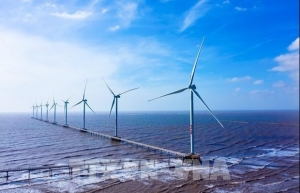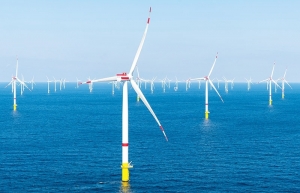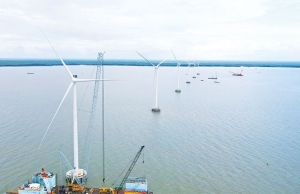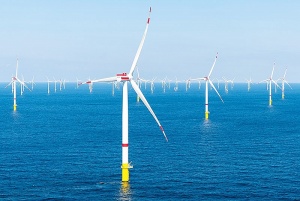Offshore wind bonanza within reach for the country
Vietnam has abundant offshore wind resources, but what are the challenges for the market?
 |
| David Harrison, partner at Mayer Brown’s Vietnam Office |
The potential is great, but as usual, success will be hard won. The market remains at a very early stage and there are a number of challenges which will need to be overcome before larger-scale offshore wind projects can be successfully implemented.
One of the most well-documented challenges remains the form of power purchase agreements (PPA) set out in Circular No.02/2019/TT-BCT of the Ministry of Industry and Trade (MoIT) from 2019 which applies to offshore wind projects. That form does not reflect the risk allocation typical for international PPAs, and the MoIT has been resistant to allowing any substantive amendments.
Whilst the PPA form has been successfully banked in both the solar and onshore wind space with appropriately structured financings, the increased scale and complexity of large-scale offshore wind projects will represent a new challenge. Securing limited recourse financing denominated in foreign currency for such projects is going to require amendments to the PPA risk allocation to align it more with international best practices.
Another key challenge is the lack of any entitlement to obtain a government guarantee. Before 2021, projects developed under the build-operate-transfer (BOT) scheme had an automatic entitlement to a government guarantee covering both Electricity of Vietnam’s payment obligations under the PPA and the MoIT’s obligations under the concession agreement.
However, under the new Law on Public-Private Partnership Investment for BOTs and the new investment law for independent power producers (IPP), both of which came into effect in January 2021, there is no longer such automatic entitlement to a government guarantee.
Decree No.31/2021/ND-CP dated March 2021 on the implementation of the Law on Investment does however give the prime minister discretion to provide security to projects under the IPP scheme, which can potentially include government guarantees. To date, no government guarantee has been issued under Decree 31, but investors are closely monitoring the progress of this issue on the various liquefied to gas-to-power projects currently being developed under the IPP scheme. The industry’s expectation is that large-scale offshore wind projects may also be developed under the IPP scheme.
In 2018, the MoIT introduced a feed-in tariff (FiT) for all offshore wind projects which achieve commercial operations before November 2021. Though this FiT has been successful in encouraging the completion of a number of intertidal near-shore wind projects, it was generally perceived to be too low for larger-scale deep-water offshore wind projects, where development costs are significantly higher.
With the FiT having now expired, the prime minister has made clear that the country will replace it with an auction-based system whereby the tariff for each wind power project will be determined by competitive bidding. The MoIT is still in the process of developing these new bidding regulations. However, critics expect the introduction of a competitive bidding mechanism to potentially slow down the development of solar and wind projects in the country.
It is generally acknowledged that an attractive FiT in jurisdictions such as Taiwan has been primarily responsible for accelerating the development of major offshore wind projects. Vietnam’s move towards a bidding mechanism at a time when the offshore wind industry remains at a nascent stage could have a counter-effect.
As such there are increasing calls for Vietnam to consider a more transitioned approach for offshore wind in order to allow a critical mass of initial projects to move ahead with the benefit of a FiT, with a subsequent transition to a bidding mechanism once the market is more mature. It remains to be seen to what extent such calls will be heeded.
How can wind energy play a bigger role in Vietnam’s energy transition, and what are the missing pieces for offshore wind to reach its potential in Vietnam?
Vietnam does not have in place specific regulations on the development of offshore wind projects. Current regulations are largely focused on onshore wind projects under Circular 02 and do not take into account the technical differences between onshore and offshore wind projects, particularly in relation to seabed lease rights, the legal status of floating and bottom-fixed offshore wind turbines, and the construction and operation of subsea transmission infrastructure.
Developers are currently required to navigate through a relatively complex process of permit requirements, necessitating coordination with numerous governmental authorities at both national and provincial levels. A streamlined permitting regime specific to offshore wind developments is yet to be enacted in Vietnam and the introduction of a transparent and simplified permitting process specific to offshore wind projects would serve to increase investor certainty.
At present, there is limited risk sharing between the government and offshore wind developers, who are expected to shoulder all early-stage development responsibilities and associated costs, even if a project does not ultimately proceed to construction.
Vietnam adopts an open-door approach to offshore wind development, underpinned by the principle that the developer is solely responsible for all steps during the project development process, including site selection; carrying out a feasibility study; applying for permits; managing the public consultation process; and resolving complaints from local residents.
Various countries and regions across the world are grappling with similar issues, so what lessons should Vietnam learn from mature markets?
In line with other Asia-Pacific jurisdictions, most recently Australia, we believe specific offshore wind legislation is required in Vietnam before the potential for large-scale offshore wind projects can be fully realised. The challenges to this fledgling industry in Vietnam are numerous, and it would be easy to become pessimistic about the prospects.
However, it is worth remembering that such challenges are not necessarily unique to Vietnam, with various countries and regions across the world grappling with similar issues – for example, streamlining and fast-tracking an overly lengthy and burdensome approval process is a target of many, as is managing the grid issues inherent in bringing multi-GW of offshore wind projects online. There is global momentum to find solutions in this space.
Reform and clear policy formulation are needed in Vietnam, but with sufficient political will, it is not inconceivable that this could occur relatively quickly, and whilst not always perfect, Vietnam does have a recent track record in implementing such reforms to catalyse its renewables sector – offshore wind represents the next major frontier.
The growing number of development-stage projects led by both domestic and big foreign investors is encouraging, and with Vietnam’s Power Development Plan VIII imminent, and COP27 later this year, we expect client interest only to increase.
 | Meeting seeks ways to tap offshore wind power The Vietnam Administration of Seas and Islands on July 22 held a hybrid consultation to seek advice on promoting the exploitation of offshore wind power. |
 | Offshore wind future in balance for Vietnam The long-awaited Power Development Plan VIII is set to target the development of about 7GW of offshore wind power in Vietnam. However, both investors and localities are waiting for a clearer roadmap. |
 | Survey overlap potential irks wind power developers Due to several legal pitfalls, conflicts may occur among wind power investors, both onshore and off, as they take part in surveying activities for their potential projects. |
 | Investors wait for wind power administration system Offshore wind offers a route to diversify the energy system in a cost-effective way, given the technology’s unmatched track record in driving down costs in the context of the major energy crisis facing the world today. |
What the stars mean:
★ Poor ★ ★ Promising ★★★ Good ★★★★ Very good ★★★★★ Exceptional
Related Contents
Latest News
More News
- Heavy industries set for pilot greenhouse gas quotas (December 25, 2025 | 10:00)
- Swedfund invests in MSME growth and climate action in Vietnam (December 19, 2025 | 11:42)
- GreenYellow brings solar energy to light up remote schools in Tuyen Quang province (December 19, 2025 | 08:00)
- Charge+, Grab partner to develop EV charging network in Vietnam (December 18, 2025 | 17:11)
- Linking sci-tech and innovation to Vietnam’s net-zero future (December 18, 2025 | 14:31)
- Driving double-digit growth through green and circular transformation in Vietnam (December 17, 2025 | 09:00)
- Standard Chartered and ACCA deepen collaboration to develop Vietnam’s talent for a sustainable future (December 15, 2025 | 18:18)
- Schaeffler reports strong early output from Dong Nai solar project (December 12, 2025 | 15:16)
- Forestry conference highlights biodiversity and sustainability goals (December 09, 2025 | 13:35)
- Home Credit honoured among top 10 sustainable companies in trade and services (December 09, 2025 | 12:18)

 Tag:
Tag:





















 Mobile Version
Mobile Version